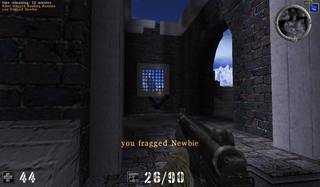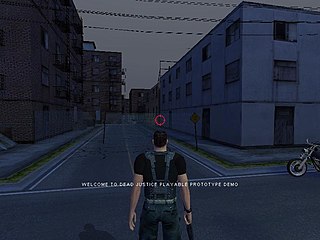
Deathmatch, also known as free-for-all, is a gameplay mode integrated into many shooter games, including first-person shooter (FPS), and real-time strategy (RTS) video games, where the goal is to kill the other players' characters as many times as possible. The deathmatch may end on a frag limit or a time limit, and the winner is the player that accumulated the greatest number of frags.

A tactical shooter is a sub-genre of first- and third-person shooters, associated with using strategy, planning, and tactics in gameplay, as well as the realistic simulations of ballistics, firearm mechanics, physics, stamina, and low time to kill. Dating back to strategy games from the late 1980s, the genre first rose to prominence in the late 1990s with the releases of several well-received tactical shooters. The popularity of the genre saw a decline in the late 2000s as fast-paced "arcade"-like action shooters rose to prominence, it has seen a revitalization since the mid-2010s with the successful releases of several modern tactical shooters.
In video gaming, camping is a tactic where a player obtains an advantageous static position, which may be a discreet place which is unlikely to be searched. The tactic is employed both in single-player games and online multiplayer games, but is usually more effective in an online multiplayer game, as AI opponents in single-player games may be aware of the player's position, even if they are visually hidden. The tactic varies depending on the type of game. In first-person shooters, it generally involves a player waiting in one location for other players to approach, then killing them before being noticed, or before the other players can react to their presence. By camping, a player is able to learn and adapt to the limited environment they are playing in, noting specific points to check repetitively. By following this method with little fault, a lower number of deaths can be achieved. In other cases, players may wait in an area to gain access to items or perform actions before other players who are not camping have the chance to do so.
Spasim is a 32-player 3D networked space flight simulation game and first-person space shooter developed by Jim Bowery for the PLATO computer network and released in March 1974. The game features four teams of eight players, each controlling a planetary system, where each player controls a spaceship in 3D space in first-person view. Two versions of the game were released: in the first, gameplay is limited to flight and space combat, and in the second systems of resource management and strategy were added as players cooperate or compete to reach a distant planet with extensive resources while managing their own systems to prevent destructive revolts. Although Maze is believed to be the earliest 3D game and first-person shooter as it had shooting and multiplayer by fall 1973, Spasim has previously been considered along with it to be one of the "joint ancestors" of the first-person shooter genre, due to earlier uncertainty over Maze's development timeline.
An action game is a video game genre that emphasizes physical challenges, including hand–eye coordination and reaction time. The genre includes a large variety of sub-genres, such as fighting games, beat 'em ups, shooter games, rhythm games and platform games. Multiplayer online battle arena and some real-time strategy games are also considered action games.
Shooter video games or shooters are a subgenre of action video games where the focus is on the defeat of the character's enemies using ranged weapons given to the player. Usually these weapons are firearms or some other long-range weapons, and can be used in combination with other tools such as grenades for indirect offense, armor for additional defense, or accessories such as telescopic sights to modify the behavior of the weapons. A common resource found in many shooter games is ammunition, armor or health, or upgrades which augment the player character's weapons.

Maze, also known as Maze War, is a 3D multiplayer first-person shooter maze game originally developed in 1973 and expanded in 1974. The first version was developed by high school students Steve Colley, Greg Thompson, and Howard Palmer for the Imlac PDS-1 minicomputer during a school work/study program at the NASA Ames Research Center. By the end of 1973 the game featured shooting elements and could be played on two computers connected together. After Thompson began school at the Massachusetts Institute of Technology (MIT), he brought the game to the school's computer science laboratory in February 1974, where he and Dave Lebling expanded it into an eight-player game using the school's Digital Equipment Corporation PDP-10 mainframe computer and PDS-1 terminals along with adding scoring, top-down map views, and a level editor. Other programmers at MIT improved this version of the game, which was also playable between people at different universities over the nascent ARPANET. Due to the popularity of the game, laboratory managers at MIT both played it while also trying to restrict its use due to the large amount of time students were spending on it. There are reports that the Defense Advanced Research Projects Agency (DARPA) at one point banned the game from the ARPANET due to its popularity.
An action role-playing game is a subgenre of video games that combines core elements from both the action game and role-playing genre.

Dungeons of Daggorath is one of the first real-time, first-person perspective role-playing video games. It was produced by DynaMicro for the TRS-80 Color Computer in 1983. A sequel, Castle of Tharoggad, was released in 1988.

Advanced Dungeons & Dragons: Treasure of Tarmin is a video game for the Intellivision video game console and the Mattel Aquarius computer system. This game was a licensed Dungeons & Dragons adaptation. It is a successor game to Advanced Dungeons & Dragons: Cloudy Mountain (1982).

Take No Prisoners is an action video game released in 1997, developed by Raven Software.

A gravity gun is a type of device in video games, particularly first-person shooters using physics engines, whereby players can directly manipulate objects in the world, often allowing them to be used as projectiles against hostile characters. The concept was popularized by the gravity gun found in Valve's Half-Life 2, as well as the Temporal Uplink found in Free Radical Design's TimeSplitters: Future Perfect; although a similar concept was used by id Software during the production of the earlier game Doom 3, eventually leading to the introduction of a physics-based weapon in the expansion pack Resurrection of Evil. Later games, such as Portal, BioShock, Crysis, Dead Space, and Garry's Mod have been influenced by the success of these physics-based weapons, adopting their own styles of comparable abilities or weapons.

In video games, first-person is any graphical perspective rendered from the viewpoint of the player character, or from the inside of a device or vehicle controlled by the player character. It is one of two perspectives used in the vast majority of video games, with the other being third-person, the graphical perspective from outside of any character ; some games such as interactive fiction do not belong to either format.

Third-person shooter (TPS) is a subgenre of 3D shooter games in which the gameplay consists primarily of shooting. It is closely related to first-person shooters, but with the player character visible on-screen during play. While 2D shoot 'em up games also employ a third-person perspective, the TPS genre is distinguished by having the game presented with the player's avatar as a primary focus of the camera's view.

A first-person shooter (FPS) is a video game centered on gun fighting and other weapon-based combat seen from a first-person perspective, with the player experiencing the action directly through the eyes of the main character. This genre shares multiple common traits with other shooter games, and in turn falls under the action games category. Since the genre's inception, advanced 3D and pseudo-3D graphics have proven fundamental to allow a reasonable level of immersion in the game world, and this type of game helped pushing technology progressively further, challenging hardware developers worldwide to introduce numerous innovations in the field of graphics processing units. Multiplayer gaming has been an integral part of the experience, and became even more prominent with the diffusion of internet connectivity in recent years.
Strafing in video games is a maneuver which involves moving a controlled character or entity sideways relative to the direction it is facing. This may be done for a variety of reasons, depending on the type of game; for example, in a first-person shooter, strafing would allow one to continue tracking and firing at an opponent while moving in another direction.

Wayout is a 3D first-person perspective video game programmed by Paul Allen Edelstein and published for the Atari 8-bit computers in 1982. It was released for the Apple II and Commodore 64 in 1983. Wayout is among the first maze games to offer full 360 degree 3D perspective and movement, and its graphics were considered state-of-the-art upon its release. There were many pseudo-3D maze games at the time, but they used a fixed perspective and limited the player to four orientations.

Total Eclipse is a first person adventure game released for the Amiga, Atari ST, Amstrad CPC, Commodore 64, MS-DOS and ZX Spectrum computers in 1988. It can also be considered an early example of a first-person shooter.
Superhot is an independent first-person shooter (FPS) video game developed and published by Superhot Team. Though the game follows traditional first-person shooter gameplay mechanics, with the player attempting to take out enemy targets using guns and other weapons, time within the game progresses at normal speed only when the player moves; this creates the opportunity for the player to assess their situation in slow motion and respond appropriately, making the gameplay similar to strategy video games. The game is presented in a minimalist art style, with enemies in red and weapons in black, in contrast to the otherwise white and grey environment.
This is a non-comprehensive list that includes terms used in video games and the video game industry, as well as slang used by players.












